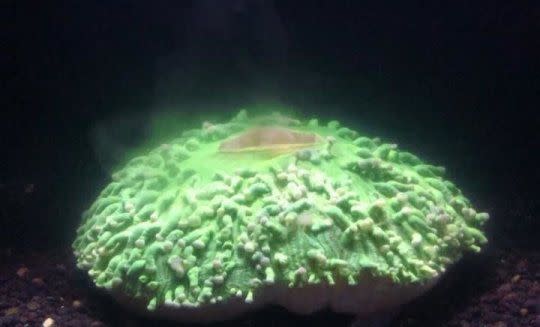Watch how coral bleaching happens in warming waters

Australian researchers have captured an event that’s happening with alarming frequency worldwide: Coral bleaching.
A team from Queensland University of Technology (QUT) in Brisbane, Australia filmed a particular type of mushroom coral as it responded to warming water temperatures.
Researchers found the solitary Heliofungia actiniformis coral inflated to more than three times its normal body size before suddenly expelling the tiny algae cells that live in a symbiotic relationship within its tissues.
SEE ALSO: A deep-sea camera just discovered a mysterious purple blob
The algae, called Symbiodinium, are corals’ main source of food and give coral their vibrant color.
But as ocean temperatures rise due to global warming and natural climate variability, corals are becoming increasingly stressed and expelling their algae.
Pollution and extreme weather events can also cause coral to shed the algae. Without their food source, coral turn white and grow more susceptible to disease and death, a phenomenon known as coral bleaching.
During the past few years, the longest-lasting global coral bleaching event on record has been occurring, a result of global warming and an El Niño event.

Image: noaa national ocean service
While scientists have long known that coral bleaching can happen, the new video provides the first recorded evidence of this particular coral species' bloat-then-burp response to heat stress, according to a peer-reviewed study published Aug. 12 in the journal Coral Reefs.
Researchers Brett Lewis and Luke Nothdurft from QUT’s marine facility used a microscope, digital camera and smart tablet to capture the moment.
They raised the water temperature in a 2.6-gallon aquarium system from 26 degrees Celsius (78.8 degrees Fahrenheit) to 32 degrees Celsius (89.6 degrees Fahrenheit) over 12 hours. The coral remained in the heated tank for up to eight days.

Image: Brett Lewis/QUT
“What’s really interesting is just how quickly and violently the coral forcefully evicted its resident [algae] symbionts,” Lewis said in a press release. “The H. actiniformis [coral] began ejecting the symbionts within the first two hours of us raising the water temperature of the system.”
But the QUT research team suggested the mushroom coral’s fast response to water stress could actually help protect it from dangerous bleaching events over the long-term.
This particular type of coral was one of the very few species on the Great Barrier Reef considered relatively resilient to bleaching, even as other nearby species suffered the worst effects.
Watching a bowling ball drop from a tower onto an axe is pretty wild
Top 10 structured movies of all time
Security guard confiscates BMX bike, promptly busts out sick moves
Underwear ad aims to flip gender stereotypes with 'dad bod' video

